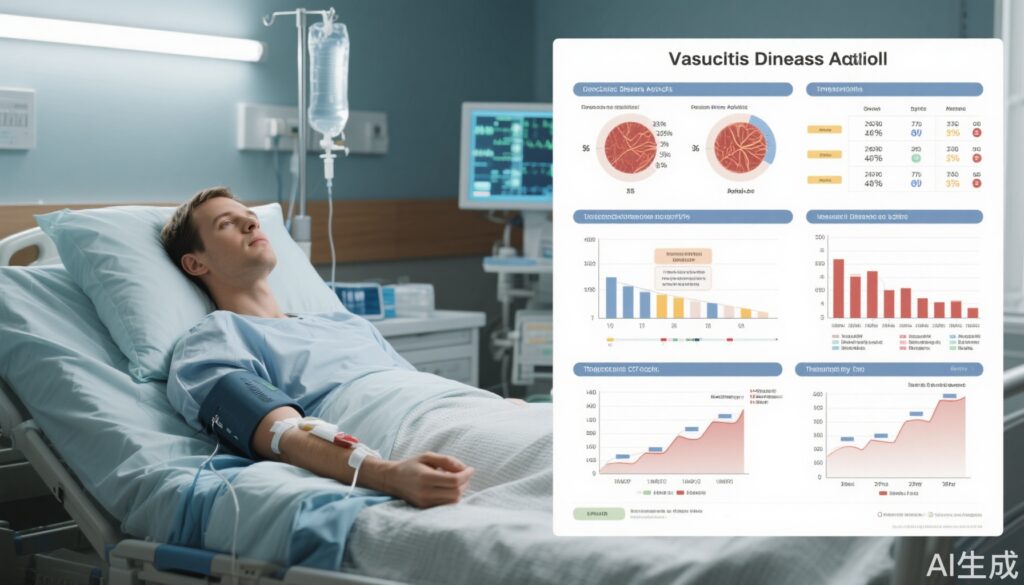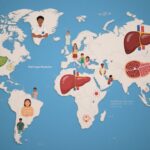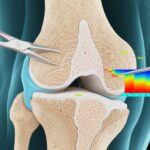Highlight
• Rituximab did not demonstrate superiority to conventional glucocorticoid-based therapy for inducing remission in EGPA at 180 and 360 days.
• Both groups achieved similar remission rates (~60-64%) and median time to remission (~2 weeks).
• No significant differences were observed in relapse rates or serious adverse events, including infections and cardiovascular events.
• These findings suggest rituximab may not provide additional benefit over conventional treatment in most patients with nonsevere EGPA.
Background
Eosinophilic granulomatosis with polyangiitis (EGPA), formerly known as Churg-Strauss syndrome, is a rare systemic necrotizing vasculitis characterized by asthma, eosinophilia, and granulomatous inflammation predominantly affecting small to medium blood vessels. The disease burden includes multisystem involvement, frequent relapses, and morbidity related to both disease activity and treatment toxicity. Standard induction therapy involves systemic glucocorticoids, often supplemented by cyclophosphamide in patients with more severe or organ-threatening disease based on prognostic scores such as the Five-Factor Score (FFS).
Rituximab, a monoclonal antibody targeting CD20-positive B cells, has shown efficacy in other ANCA-associated vasculitides, particularly granulomatosis with polyangiitis and microscopic polyangiitis. However, its role in EGPA remains uncertain due to the disease’s heterogeneous pathogenesis involving eosinophils and Th2-mediated immunity in addition to B-cell–mediated mechanisms. Prior to this study, evidence for rituximab in EGPA was limited to observational reports and small case series.
Study Overview and Methodological Design
This phase 3, multicenter, randomized controlled superiority trial conducted in France enrolled 105 adult patients with active EGPA, defined by a Birmingham Vasculitis Activity Score (BVAS, version 3) ≥ 3. Patients were recruited from December 2016 to October 2019 and randomized to receive either rituximab (n=52) or conventional therapy (n=53) stratified by Five-Factor Score (FFS).
The rituximab arm received two infusions of 1 g rituximab on days 1 and 15, alongside a standardized glucocorticoid taper. Patients with FFS ≥ 1 also received placebo cyclophosphamide and uromitexan to maintain blinding. The conventional therapy arm received glucocorticoids with or without cyclophosphamide depending on FFS ≥ 1 status.
The primary endpoint was remission at day 180, defined as BVAS of 0 and prednisone dose ≤7.5 mg/day. Secondary endpoints included remission duration, glucocorticoid dose, relapse rates, and safety assessed through 360 days.
Key Findings
At 180 days, remission was achieved by 63.5% in the rituximab group and 60.4% in the conventional therapy group (relative risk 1.05; P=0.75), indicating no superiority of rituximab. At 360 days, remission rates remained similar: 59.6% (rituximab) versus 64.2% (conventional).
The median time to remission was 2 weeks in both groups. Among patients achieving remission (BVAS=0), the mean remission duration was comparable, 48.5 weeks for rituximab and 49.1 weeks for conventional therapy.
Relapse rates and serious adverse events, including infections and cardiovascular complications, did not differ significantly between groups. No unexpected safety signals were identified.
Mechanistic Insights and Pathophysiological Context
EGPA pathogenesis involves complex immune dysregulation with prominent eosinophilic inflammation, Th2 cytokine profiles, and sometimes ANCA positivity. Rituximab’s targeting of B cells affects antibody production and antigen presentation but may not sufficiently modulate eosinophilic or T-cell–mediated pathways critical in EGPA.
This trial’s results suggest that B-cell depletion alone does not confer a clinically meaningful advantage over glucocorticoid-based regimens, especially in nonsevere cases. The findings align with the paradigm that EGPA’s heterogeneous immunopathology may require multifaceted therapeutic approaches beyond B-cell targeting.
Clinical Implications
These data support continuing glucocorticoids with or without cyclophosphamide as the first-line induction therapy for most patients with active EGPA, particularly those with nonsevere disease presentations. Rituximab should not be routinely preferred for remission induction in EGPA outside of clinical trials or specific indications.
Physicians should consider individual patient factors such as organ involvement severity, ANCA status, and comorbidities when tailoring therapy. The lack of rituximab superiority may influence treatment guidelines and insurance coverage decisions.
Limitations and Controversies
Limitations include the study population predominantly with nonsevere EGPA, potentially limiting applicability to severe or refractory cases. The 360-day follow-up, while adequate for induction assessment, may not fully capture long-term relapse patterns or late adverse events.
The trial did not explore combination biologic therapies targeting eosinophils or T cells, which may be more effective given EGPA’s pathogenesis. Additionally, the placebo-controlled design for cyclophosphamide in the rituximab arm, while methodologically sound, may obscure nuanced comparative effects.
Expert Commentary or Guideline Positioning
The French Vasculitis Study Group authors conclude: “In most of the study population with nonsevere EGPA, the lack of a clinically meaningful effect of rituximab in addition to the conventional strategy of glucocorticoids alone may appropriately inform clinical decision-making.”
Current international vasculitis guidelines emphasize glucocorticoids and cyclophosphamide or methotrexate for induction, with rituximab reserved primarily for ANCA-associated vasculitides other than EGPA. This trial provides high-quality evidence reinforcing that stance.
Conclusion
This rigorously conducted randomized trial demonstrates that rituximab is not superior to standard glucocorticoid-based therapy for remission induction in EGPA. Similar remission rates, relapse incidence, and safety profiles suggest conventional therapy remains the mainstay for most patients.
Future research should focus on targeted therapies addressing eosinophilic and Th2 pathways, biomarkers predicting treatment response, and long-term outcomes. Personalized medicine approaches may ultimately optimize EGPA management beyond the current paradigm.
References
Terrier B, Pugnet G, de Moreuil C, Bonnotte B, Benhamou Y, Chauveau D, Besse MC, Duffau P, Limal N, Néel A, Urbanski G, Jourde-Chiche N, Martin-Silva N, Campagne J, Mekinian A, Schleinitz N, Ackermann F, Fauchais AL, Froissart A, Le Gallou T, Uzunhan Y, Viallard JF, Bérezné A, Chiche L, Taillé C, Direz G, Durel CA, Godmer P, Trad S, Lambert M, de Menthon M, Quéméneur T, Cadranel J, Charles P, Dossier A, Jilet L, Guillevin L, Abdoul H, Puéchal X; French Vasculitis Study Group. Rituximab Versus Conventional Therapy for Remission Induction in Eosinophilic Granulomatosis With Polyangiitis: A Randomized Controlled Trial. Ann Intern Med. 2025 Jul 29. doi: 10.7326/ANNALS-24-03947.



